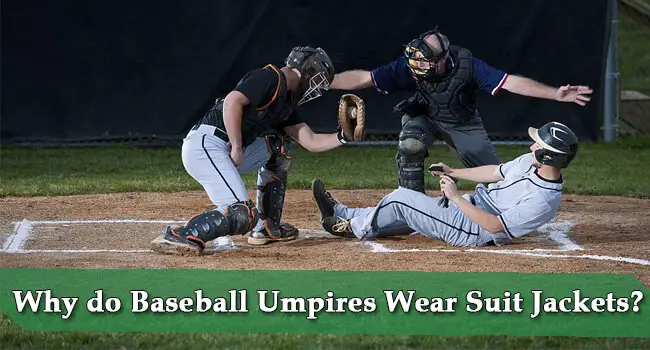
In Baseball, an umpire is a person in charge of on-field rules and decisions. It includes enforcing the laws of the game from start to end, making judgments and handling all disciplinary actions.
But have you ever thought why do baseball umpires wear suit jackets?
Why do Baseball Umpires Wear Suit Jackets?
Umpires wear suits for the majority of baseball history of 200 years. Suits serve to separate the umpires from the players in the game. It also imbues the umpires with a sense of authority.
If there is a disputed call, then the player or the coach does not punch or strike the umpire, but they kick dirt on his suit. In later 200 years, an umpire’s suit is as important as the player’s uniform.
How was the Uniform of Umpires?
Umpires are referred to as “Blue” because of the color of their uniform. In the early days of Baseball, the umpire uniform as a suit was different. In the National League, they wore an inside chest protector, whereas, in the American league, umpires wore an outside chest protector.
With time, the umpire uniform has evolved to grey slacks with a blue coat. Every professional coat has a patch of the embroidered league logo. In 1996, light blue shirts were replaced with navy-blue polo shirts.
Now, the new uniform has been introduced in the 2017 season, with a black jacket and light blue trim over the shoulders.
What is the History of Umpire’s Uniform and How it is Evolved?
Umpiring is the legitimate profession where umpire’s uniform was significant in the 19th century.
- The Plate Coat: To establish legitimacy, the American Association and the National League concluded that umpire should have a professional uniform. And nothing is more professional than a suit. The very first umpires wear a suit with full pants, shirts, ties, and hats.
- Hats: Umpires use protective headgears called “sunshade hats” that allows them to shield their eyes from the sun without using any shade umbrellas. University-style caps had made their way onto field umpire heads. Boston-style caps were favored by the plate umpires who need smaller hats under their facemasks.
The hats were standardized and embroidered with the stamps of the governing league’s emblem or logo.
- Suits: Umpire suits were comprised of at least two components: matching pants and a jacket of the same fabric.
- Pants: Once the National League experimented the uniform with the white trousers for the umpire in Baseball, the manager-umpires argued that they are tired of players kicking dirt on them and it is challenging to carry dirty pants. Then, at one point, Baseball attempted to return to the blue pants, that were colored heather and charcoal grey to camouflage any potential dirt stains and preserve the dignified suit slacks look.
- Jackets: Umpire jackets were the large blazers that accommodate the significant equipment requirements. Earlier, blazers had large pockets to hold spare baseballs. Blue was the dominant color of the umpire’s upper wear. In the mid-20th century evolution, American League experimented with maroon blazers and plate coats to distinguish its staff of the National League, with their logos and patch them on the shirt’s left breast quadrant.
- Shirts: Later in the 20th century, suit-era stiff collared shirts evolved into chest predator-accommodating button-down shirts, which was replaced by more flexible poly-style shirts. The umpire wore shirts with white or light blue shade along with dark blazers over them. When this piece of heavy outwears left the base umpires’ wardrobe, they were replaced by black polo shirts.
In 1996, the button-down light blue shirts were replaced with a navy-blue polo shirt along with red and white trim on the sleeve cuffs and collar.
The numbers were also changed to red on the shirts. ‘N’ was embroidered with the National league logo and ‘A’ with the American League logo on the hats.
A short-sleeved red shirt was used as an optional by the American League that was not used by many umpires. The National League added a light blue shirt in 1997, which became more popular than red shirts in the American League.
Since 2001, the uniforms are switched to black blazers with grey slacks, with the hats including the MLB logo, which remain unchanged.
The navy-blue shirt was phased out of black, and the light blue shirt was reintroduced after a small experiment with grey. For the 2017 season, black umpire’s jacket with light blue trim over the shoulders was introduced.
Why Umpire’s Plate Coat Has Been Evolved?
With the game of Baseball, umpire’s uniform has been evolved. There are the following reasons for the evolvement of umpire’s uniform.
- Not a Big Market: The main manufacturer of plate coats made only 24 plate coats in total in a year that includes one for umpires in the major leagues who get them for free.
- Expensive: Buying a new plate coat was expensive in those days. The price of the suit was $250.
- Take So Much of Time to Receive: It takes about 12 weeks for the package to be received. It was a long time to wait for the package.
- Difficult to Pack: It was required to spend $250 on a plate coat, but it was complicated to pack and carry. It was always necessary to lug it around themselves.
- Only Dry Clean: Those coats can only be dry cleaned. It is another added expense with it.
- Criteria of Modern Umpire Apparel: Today’s umpire apparel provides a mix of athleticism and authority. Plate coat achieves the authority part but not the athleticism. If you cannot wear a sport coat at the gym, then how can you wear a plate coat in the field?
Final Thoughts
Baseball umpires are few remaining people that wear suits in professional sports. But why do baseball umpires wear suit jackets? Umpire suits are a sense of authority that separates the umpire from the players in the field.
